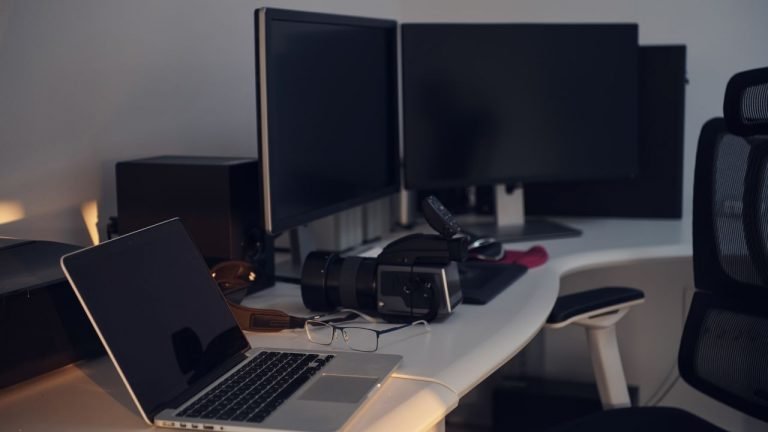Is 32 Inch Monitor Too Big For Home Office?
There are hundreds of reasons why people want a 32-inch monitor. For example, to have a better gaming experience, watching movies, digital painting, and so on. But, what about a 32-inch monitor for your desk? In other words, Is a 32-inch monitor too big for the home office?
You can use a 32-inch monitor for your home office. We recommend you to settle on a 32″ monitor with 1080p resolution if the work only involves reading or typing. However, for a better video experience or creative tasks, you can’t go lower than 1440p for a 32″ screen.
That was just the preview of what we will be discussing below. In this article, we will try to visualize how it feels to own a 32″ monitor in different work settings. So that, you can make up your mind more easily.
Now, without further ado, let’s jump into it.
How Far Away Should I Sit From A 32-inch Monitor?
You can sit 60 to 100 cm away from the monitor for a clear view. Depending on the screen width, you can increase or decrease the ideal distance. As for a 32 inches screen, it is recommended to stay within 80 to 96 cm. But this is not the only answer.
You see, apart from screen width, other factors affect your field of vision. That means, if the screen has a higher resolution, you can enjoy the same crispy picture from a closer angle. If you have sat in the first row of a movie theater before, you might know this well. Because the same video looks pretty good when you run it on your 24″ monitor.
On the other hand, you can see the pixels when you sit in the first row at a movie theater. Only the people in the middle row are at a decent distance to make up for the low pixels.
We have a small table that will prove it to you. Most professionals think a 27 inches screen having at least 1080p resolution offers the right level of crispiness. You need to stay about 42 inches or 107 cm away from the screen to experience the best quality.
But what will be the distance if you switch to a 32 inches monitor? We have shown the distance (cm) required to get the same quality images of a 1080p and 27″ monitor. Check it out.
| Monitor | Resolution | Distance |
|---|---|---|
| 27 inches | 1080p | 107 cm |
| 27 inches | 1440p | 81 cm |
| 27 inches | 2160p | 53 cm |
| 32 inches | 1080p | 127 cm |
| 32 inches | 1440p | 94 cm |
| 32 inches | 2160p | 64 cm |
Don’t know how resolution work? We have a brief explanation below. Take a look.
What Does Resolution Mean?
To understand the discussion better, you have to understand what resolution means and how it affects your experience.
Each screen has a resolution that helps us understand the image quality. It is a combination of two numbers (3840×2160). The first number indicates the number of pixels available horizontally. While the other numbers are for the vertical axis. Needless to say, the more pixels you get, the sharper image you can see.
As you can see, the higher you go, the less distance you need for clear images. The extra pixels per inch make up for the loss of distance. Another useful trick is to measure the screen diagonally. Then, multiply 1.5 or 2 with that number. That’s the minimum distance you should keep.
What Is the Best Monitor Size For Office Work At Home?
We wish we could tell you one right size. Since works vary for every person, so does the right monitor size. That’s why we have categorized some common office tasks. You can check which category resonates the most with your work type. Then, it would be easier for you to choose a monitor size.
Programming / Coding
A programmer can ask for nothing more than the right monitor size. All of their work involves a digital screen. Our suggestion would be to focus on the screen size only. Because bigger screens allow you to work on multiple apps at the same time. You don’t have to swipe frequently between apps and lose track of your work.
It’s more effective for new programmers who want to watch a tutorial and practice at the same time. You wouldn’t need two separate devices, as a 32-inches monitor is big enough.
It hardly matters whether the resolution is 1080p or 1440p. plus, 4k resolution would be too overwhelming for a typical coding computer.
Creative Tasks
By creative tasks, we are mentioning activities that require intense focus for a longer time. For example, painting, digital art, editing, photography, etc. You need to spend the whole day working on small details of the art.
If the screen is not big enough, how are you going to notice the mistakes? Plus, for some tasks, you need to compare the output with a model continuously. If you have a wide screen, you can have two tabs open at the same time. We would definitely suggest a 32-inch monitor if your work is like that. Or, you can go bigger and choose a 34-inches monitor.
Typical Office Tasks
For typical office tasks like typing, proofreading, and copywriting, you wouldn’t need more than 24 inches monitor. To create better presentations and edit projects, a 1980 x 1080p resolution suits best. Even a 21-inches monitor with a 720p resolution will work if you want to save money. However, to avoid straining your eyes while reading, try to keep the fonts bigger.
Refreshment
We are definitely going to take breaks. Sometimes, how the monitors serve our refreshment purposes, matters more than the work type itself. Let’s understand the right monitor size for different refreshment activities.
Movies
If you want to enjoy movies on a big screen, 32-inch monitors would work perfectly. Since you don’t have to sit close in front of the desk, it doesn’t matter what the resolution is. If the resolution is 1080p instead of 1440p, you might have to set your seat further. The lower image quality won’t become too prominent in this case.
Fast-Paced Games
Another refreshment activity is playing games. Suppose you like playing games that require fast response. You have to notice the surrounding very clearly. In that case, we would suggest you keep the screen smaller without changing the resolution.
Because a 32 inches monitor would need more pixels to provide the same image quality as a 27″ or 24″ screen. Plus, gamers have a common complaint regarding ultrawide screens. They have to continuously tilt their neck or move their eyes to take in the entire background. That’s why many pro gamers would prefer a 27″ screen with 1440p over a 32″ screen with the same resolution.
Slow-Paced Games
Now, let’s move on to slow-paced games. You can take Minecraft for example. A smaller screen affects your ability to connect to the 3D world. On the other hand, if you use a 32″ monitor, it would allow you to see more of the background. Since the sharpness hardly matters here, 32-inch monitors would be a perfect fit.
What Type Of Desk Do You Need For A 32-inch Monitor?
You need a deeper desk to accommodate a 32-inch monitor. The typical office desks are designed for 24″ monitors. So, you can’t expect it to be stable enough with a 32-inches monitor too.
The best option is to multiply 1.5 to 2 with your monitor’s width. In that case, having at least a 47 to 55 inches desk is necessary for a widescreen monitor. Leaving some extra inches by each side makes sure that the monitor won’t trip off accidentally. Plus, you have the space to keep objects like a mouse, notepad, penholder, etc.
That being said, pay attention to the desk’s thickness as well. For example, a large desk with ½” of thickness won’t be stable enough for an ultrawide monitor. We suggest you choose a sturdy material too. Pinewood looks very stylish and lasts long at the same time.
What Resolution Do I Need For A 32-inch Monitor?
Resolution plays a big factor in choosing the right monitor size. Your screen experience depends entirely on it. If you want a one-word answer, we would recommend a 2k resolution. It is also known as 1440p. According to eye experts, 1080p resolution is enough for day-to-day working activities like reading emails, attending seminars, etc.
But, if you want to imply 1080p on a 32 inches monitor, your seat needs to be further away. Suppose you currently have a 27″ monitor with 1080p and your chair is 42 inches away. If you increase the monitor’s width, you will have to set your chair further. Otherwise, the picture quality won’t be as sharp as before. It might feel blurry.
That’s because each square inch should contain at least 300 pixels for crystal clear videos. Now, if the monitor’s dimension increases, you will have fewer pixels per square inch. Do you remember our thumb rule? Fewer pixels or lower resolution leads to broken or blurry images.
As for the high-quality UHD (Ultra HD), that would be too much on a 32 inches monitor. You can definitely use it for video editing or animation tasks. As these works require excessive attention to detail. Plus, if you enjoy slow-paced games, you would love a 4K resolution. It helps you immerse into the game even more. However, if you are talking about basic office work, we would recommend you to stick with 1440p only.
Here’s a small table to understand the resolutions better:
| Resolution | Pixels |
|---|---|
| HD Ready | 1024 x 720p |
| Full HD | 1980 x 1080p |
| QHD | 2560x 1440p |
| UHD | 3840x2160p |
32-inch Monitor VS Dual Monitors- Which One Is Better?
A dual monitor set-up is an alternative of having a 32-inch ultrawide screen. But, do they both provide same advantages? If not, which one is comparatively more beneficial for you? Don’t worry. Here, you can see the detailed analysis.
Eye-Strain
A 32-inch screen or a dual monitor set-up emits blue lights. So, your eyes are in danger equally. However, if we talk about eye movement, dual monitors are more straining. That’s because you can keep multiple windows open on your 32-inch screen. whenever you need to switch to another app, just expand the window. Your eyes don’t have to work harder.
While the dual monitors require your eyeballs to move frequently from one screen to another. Especially if you are working and playing games at the same. At the end of the day, you might have blurry vision or eye dryness.
That being said, smaller screens like 24″ or 27″ are more comforting for the eyes than a 32″ monitor.
Neck Pain
It is connected to our previous explanation. Since you keep moving your eyes from one monitor to another, your upper neck can start hurting. That’s why if you ever decide to buy dual monitors, use a monitor arm. It will allow you to keep a specific screen in front of you whenever you wish.
If you don’t like the idea of spending money on these wall mount stands, you are going to feel neck or upper body pain pretty soon. To avoid this, having a 32-inch monitor seems to be a better option
Productivity
When it comes to productivity, dual monitors have proven to win the race. That’s why it’s common to see employees having two monitors at the desk instead of a 32 or 34-inches screen. You see, when you are working on a monitor with lots of open tabs, it’s easier to get distracted. You notice one message and open another app. It’s easy to lose track of time.
As your personal life keep interrupting your work, it might take way too long to finish. And, you end up feeling more tired.
On the other hand, dual monitors discipline you to focus on one task at a time. You can easily separate your personal life from work life using two screens. When it’s time to take a break, you can check your emails and texts on the other monitor. And, then move on with your existing project. So, dual monitors take the points in this situation.
Expense
When it comes to money, a 32-inch monitor is your best bet. You can get a high-resolution big screen for $169 to $200. However, if you choose to get two 21″ monitors, per unit cost be around $100. But that doesn’t end here. You have to add a monitor stand or arm for better stability. That takes the price to $300 minimum.
In our opinion, you should avoid dual monitors if you want to enjoy the big screen and still save your money.
Final Note
Who doesn’t want to have a big screen with the highest resolution? But bigger is not always better. In the case of your monitors, this saying is 100% true. Unfortunately, we all have to consider things like budget, eye health, usefulness, etc before placing an order.
In this article, we have tried to give you a glimpse of whether a 32″ monitor is too big for your home office or not. We have talked about resolutions, ideal distance, desk types, and so on.
Hopefully, you have all your doubts clarified. Now, it’s up to you whether to go for it or not.
Good luck!
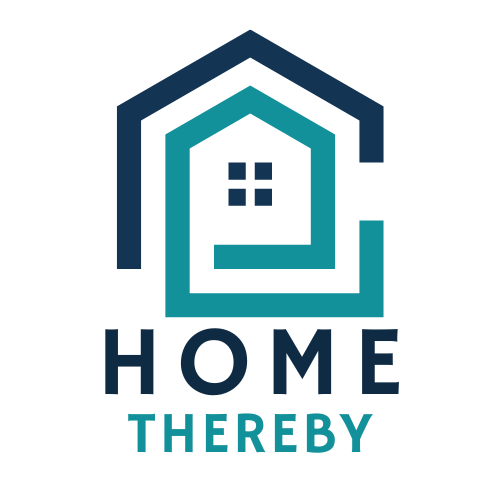
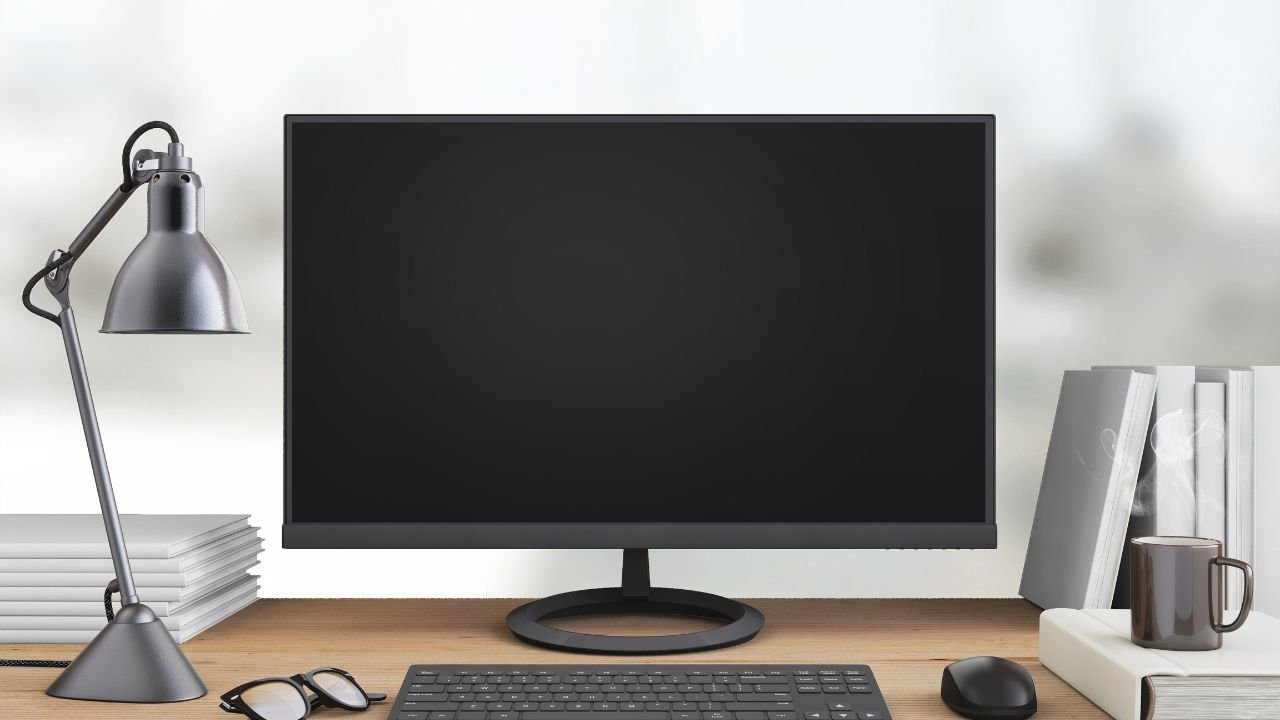
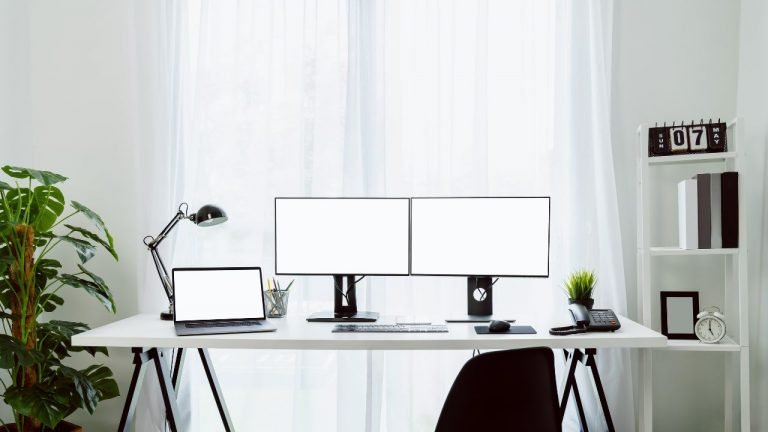
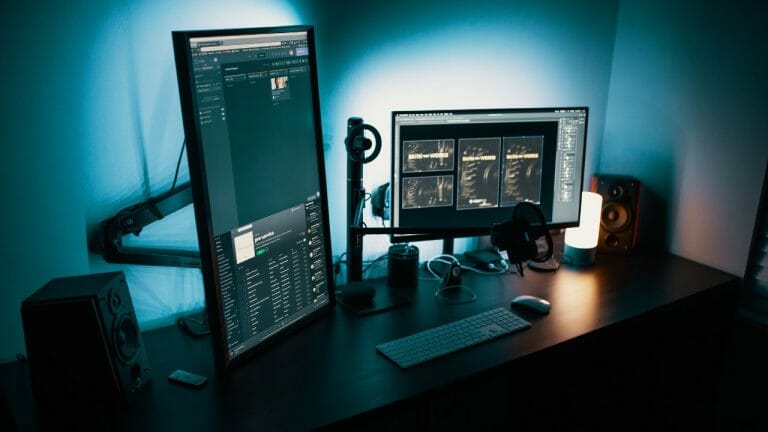
![Should Dual Monitors Be Angled? [Or Not]](https://homethereby.com/wp-content/uploads/2023/04/Dual-Monitor-Gaming-Setup-768x432.jpg)

